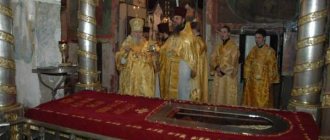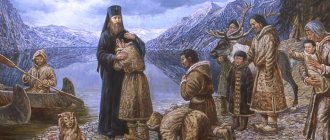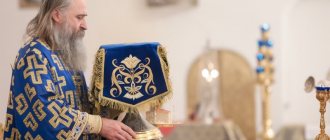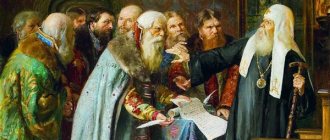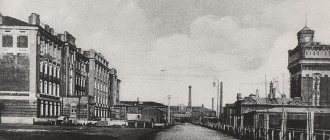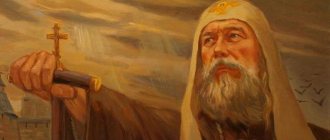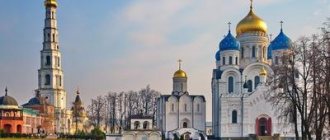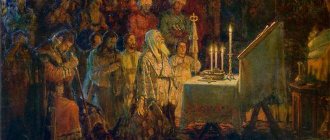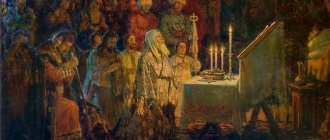On January 12 (December 30, Art. Art.), the memory of St. Macarius, Metropolitan of Moscow, is celebrated. Under him, two Councils were convened: 1547 and 1549, at which the issue of glorifying the ascetics of piety was raised. These Councils were of great importance for the life of the church and went down in history under the name “Makarievsky”. In 1551, under the leadership of the saint, the Council of the Hundred Heads was held, which confirmed, among other things, the sanctity of the double finger. Metropolitan Macarius also compiled the Great Chetya Menaion, which included the lives of saints, works of church writers, collections of patericons, texts of a historical and moralizing nature by Russian authors, arranged in order of celebrating the memory of saints according to the Orthodox calendar for each month.
Childhood and youth
The worldly biography of Metropolitan Macarius began around 1482. The boy, named after the Archangel Michael, was born in the home of believing citizens of the Grand Duchy of Moscow. Our ancestors faithfully served the Orthodox rulers.
In the family of the religious figure there were many people associated with the church. Among the family memorials were Joseph Volotsky, Abbot Vassian, Priest Ignatius, Archimandrite Cassian and a number of other holders of spiritual titles.
Posted by Vera Rusina on Tuesday, June 9, 2020
Icon of Metropolitan Macarius
Little is known about the parents. A father named Leonty died shortly after his son was born. The mother, left without a husband, went to a monastery and took monastic vows as nun Euphrosyne.
As a child, Mikhail, raised in the traditions of the Orthodox faith, decided to renounce the world and become a novice. In the Pafnutiev-Borovsky monastery, located at the confluence of the Isterma and Protva rivers, it was named in honor of the hermit Macarius the Great (of Egypt), revered by parishioners as a saint.
Then the young man entered the monastery that Joseph of Volotsky inherited from the venerable father Paphnutius. The teacher and founder of the Joseph-Volokolamsk Assumption Monastery had a huge influence on the worldview of the future metropolitan.
For several years the monk studied church literature. Senior comrades helped to comprehend the meaning of prayers and rituals, as well as the art of icon painting. Secluded in his cell, Leonty’s son spent his days thinking about humility and monastic deeds; this helped him get used to the hardships during long, strict fasts.
Oryol Metropolis
Hieromartyr His Eminence Bishop Macarius (in the world Mikhail Vasilyevich Gnevushev) From January 28 to May 1917 - ruling bishop of the Oryol diocese.
Born in 1858 in the village of Repyevka, Ardatovsky district, Simbirsk province.
In 1882 he graduated from the Kyiv Theological Academy with a candidate of theology degree and was appointed teacher at the Kiev-Podolsk Theological School.
1883 - mentor of the Ostroh Teachers' Seminary. 1885 - teacher at the Kyiv Women's School. 1890 - teacher at the Kyiv Theological Seminary.
In 1908, he was tonsured a monk, ordained a hieromonk, and appointed rector of the Moscow VysokoPetrovsky Monastery and elevated to the rank of archimandrite.
In 1909, the Holy Synod moved him to the position of abbot in the Moscow Novospassky Stavropegial Monastery.
On July 11, 1914, he was consecrated Bishop of Balakhninsky, vicar of the Nizhny Novgorod diocese. The consecration took place in Nizhny Novgorod.
On July 11, 1914, in Nizhny Novgorod, he was consecrated Bishop of Balakhninsky, vicar of the Nizhny Novgorod diocese. Already in the rank of bishop, he took part in the Conference of Monarchists on November 21–23, 1915 in Petrograd (Petrograd Conference), at which he was elected to the Council of Monarchist Congresses.
On January 28, 1917, he was appointed to an independent see - Bishop of Oryol and Sevsky.
The decree of the Holy Synod dated February 1, 1917 says: “The Sovereign Emperor, on the 28th day of this January, deigned to most eminently approve the most submissive report of the Holy Synod on the release of Bishop Gregory of Oryol, due to his illness, from the administration of the Oryol diocese and on the existence of the vicar of the Nizhny Novgorod diocese, Bishop Macarius of Balakhna as Bishop of Oryol and Sevsky.” As the Oryol Diocesan Gazette reports: “On Saturday, February 25, in the morning, His Eminence Macarius, Bishop of Oryol and Sevsky, arrived in Orel by mail train from Moscow. At the station the Right Reverend was met by the Head of the province, Count P.V. Gendrikov, Vice-Governor N.K. Komarovsky, mayor I.A. Gumbin, some heads of military and civilian units, the rector of the theological seminary, the cathedral archpriest and the cleric of the cathedral, members and secretary of the consistory, the dean of the city churches, the observer of parochial schools, the chairman of the council and the inspector of classes of the Diocesan Women's School, etc.” The eagle greeted His Eminence Macarius with a “red ringing” from the bell towers of all the churches in the city. However, in less than three months the Bishop will be slandered and removed from the Oryol See. But on this day, as Bishop Paul said in his welcoming speech: “Most Reverend Vladyka, our Most Gracious Archpastor and Father! The Oryol flock, given to you by God, greets you with triumph and joy. ...We are pleased with your God-loving image, already quite widely known and revered by many, many Russian people, the image of a faithful champion and fighter for the primordial principles of Holy Russian life, a courageous and convinced herald and recognized leader of that true society, that unity of the rational forces of the country that are striving to find support ourselves in the fundamental foundations of the existence and life of our Fatherland, support in the one true faith professed by the Orthodox Church. ...Especially at this time, your coming to us, by God’s will, is dear to us, when we and all of Russia are experiencing such a formidable visitation of the wrath of the Lord - an unprecedentedly terrible war with an external enemy, confusion of minds, disorder and anxiety within Russia, when we are experiencing such difficult trials , and perhaps even more severe trials await us ahead.”
In his speech “To guard peace and love” upon entering the Oryol See, Bishop Macarius, greeting the Orthodox people of the Oryol land, addresses them with the words of our Lord Jesus Christ: “Peace be with you.” “Peace in all areas of your life. Peace is in external relationships. Peace is in the soul. Peace is in the conscience. …Peace is the first and most important step to love.” Further, the bishop said that the Lord called him to serve the Oryol flock in one of the most difficult and dangerous times in the historical life of the Russian people. “Anti-state activity is flaring up among those sections of our people who have a destructive intention - to use the terrible hour of national and state life either for the purposes of their political parties, or to satisfy low passions - self-interest and pride. ...But, dear children of the Church of God, no matter how terrible, no matter how dangerous the current war is for the political existence of our people, we must remember that, as before, an even more dangerous, even more terrible war is going on. ... This is the most stubborn, never-ending war of all those forces of this world against Christ, His teachings, His Church, against the salvation of people from temporary and eternal torment.” Addressing his contemporaries, Hieromartyr Macarius also addresses us with words that are very relevant in our time: “The war against the saving teaching of Christ, which never ceases, has especially intensified at certain times in the life of mankind. ...The entire Christian world, carried away to self-forgetfulness by the successes of the sciences, inventions and discoveries, proud beyond all measure, was filled with the deeds of this pride, saw before it new teachers, striving in every possible way to turn the eyes of mankind away from heaven and chain them exclusively to the earth and its benefits. A terrible wave of unbelief and extreme moral debauchery is rising more and more in human life, flooding and destroying more and more human souls. ...Everything pagan, everything anti-Christian, is especially easily spread and accepted through the strengthening and development of a vicious life. ...There is no moral responsibility, live for your own pleasure.” Further, Bishop Macarius noted the destructiveness of schismatic and sectarian activities. ... Let us not hide from ourselves that hostility and open war against Christ, against His teaching, against His Church and among us, among our people, has reached its extreme limits.” Concluding his address to the flock of the Oryol diocese, Bishop Macarius called on everyone to stand guard over the peace and love of Christ. Having blessed each of those present after his speech, the bishop left the station for the bishop's house, where in the Church of the Cross he was met by the brethren and abbess of the Vvedensky Monastery, Mother Eugenia, who presented him with the icon of the Balykino Mother of God.
The transfer of the Right Reverend Macarius to the Oryol See coincided with very tragic events in the fate of Russia. Five days later, on March 2 (15), Russia no longer had God’s chosen government. One can only imagine the experience of a Russian Orthodox person regarding this historical event, especially an educated person who loves the Fatherland with all his heart, imagining the consequences of this tragic event. Nevertheless, the bishop remains in strict obedience to the Church. In a letter with a Decree from the Holy Governing Synod of March 9 (22) on the reading in the churches of the diocese of the act of abdication of Nicholas II from the throne, he writes a resolution on March 12: “The acts of abdication have already been read. At the next service, read the message enclosed with this.”
The bishop’s activities for the benefit of the Church and the state not only did not weaken, but even more intensified. He leads divine services in Orel and its suburbs almost every day; his sermons are distinguished by his depth of knowledge of history and love for his listeners. His Eminence Macarius warns: “Remember that along with the various ways to ensure unity and freedom, the most important is the one that underlies church life: the unification of all flocks and flocks lies, first of all, in the unity of faith, the holy sacraments and the hierarchy.” He opposes renovationist trends in the Church, meets with teachers and students of Orel religious educational institutions, organizes honoring of the oldest parish clergy of the diocese, and publishes a seemingly narrowly professional article “Beekeeping and the Orthodox Clergy.” However, after reading this work, you see how modern it is - how necessary in our time, and perhaps more necessary than a hundred years ago, is the introduction of such a subject in schools, in Sunday schools and religious schools. The Bishop devotes a lot of time to organizing spiritual life in the diocese: “In view of the importance of those taking place with
events, I ask all the clergy to make every effort and means for unity, both among themselves and with the parishioners.” The Bishop blesses and asks to hold pastoral meetings with the involvement of the laity, conducts preparations for the diocesan congress of the clergy, takes care of preparations for the entrance exams to the Livensky and Sevsky Theological Schools, systematically, through the Oryol Diocesan Gazette, addresses archpastoral messages to “Beloved shepherds and Orthodox children of the church and lands of Oryol".
These messages testify to the prophetic vision of the ruler of the future destinies of the people and the country. Repeatedly, the future martyr says that anger, envy, strife, a sense of revenge, vanity, have led and are leading people to mutual irritation, to mutual remorse and devouring, and, ultimately, to self-destruction. “God save us from this great grief! God! Save Holy Rus' from strife, quarrels, and civil strife!” Today we see that the prayers of the holy martyr did not go unheard by the Lord, and today is confirmation of this. Sincere devotion to Orthodoxy, love for the Fatherland and people could not go unpunished by the forces of darkness, who set themselves the task of destroying the Church of Christ in Russia, and therefore Russia. The April issue of the Orlovsky Vestnik newspaper publishes a telegram addressed to the Holy Synod and the Chief Prosecutor about the removal of Bishop Macarius from the Oryol see. In his response to this article, published in the Oryol Diocesan Gazette, entitled “Truth and impartiality are the basis and source of true freedom,” the Bishop, analyzing the appearance of this telegram, sets out in detail the true reasons for the discontent of that part of society that is indifferent to the fate of Russia and hates the Church of Christ . The Bishop’s address ends with the word “Easter Imperishable,” which is impossible for our contemporary to read without emotional excitement: “We constantly die to the past, partly to the present, in order to be resurrected and live for the future, in order to more widely and deeply embody the ideal that is dear to us in our lives.” . These words were realized in the earthly and eternal life of the holy martyr Macarius.
On April 14, 1917, His Grace Macarius left Orel for Petrograd upon being summoned to the Holy Synod to report on the situation in the diocese. In May, Bishop Macarius returns to Orel. His last article was published in the June issue of the Diocesan Gazette: “To the Orthodox clergy of the Oryol diocese.” The bishop took the words of the apostle as the epigraph to this article: “Be careful how dangerously you walk... These are the days of evil... Watch and pray, so that you do not fall into misfortune.” With bitterness, the Bishop states: “Looking at the phenomena of current life, one cannot help but notice, first of all, that the parish pastors almost did not respond to my call for unity among themselves and with the laity and therefore, it seems to me, they remained completely defenseless against the machinations and malicious wishes of evil in the parishes and clergy of persons who often unite with the Social Democrats, and against the flatterers and deceivers who have thrown the banner of freedom and unification over their heads, but in fact have sowed and are sowing confusion and doing the same disastrous work as the famous Lenin and his comrades.”
Soon, persecution began against Bishop Macarius for his monarchist views and activities, and on May 26, 1917, the bishop was dismissed with the determination of his place of residence in the Spaso-Abraamiev Monastery in Smolensk, and from January 1918 he was transferred to the Spaso-Preobrazhensky Monastery in the city of Vyazma.
On August 22, 1918, the ruler was nevertheless arrested on the absurd charge of “organizing a White Guard uprising.” After his arrest, he bravely endured mockery and beatings. On September 2 he was transferred to the Smolensk provincial prison, and on September 4 he was convicted by the Cheka of the Western Region for “counter-revolutionary activities” and sentenced to death.
On September 4, 1918 he was shot in Smolensk, rehabilitated on April 14, 1993.
Glorified in the host of New Martyrs and Confessors of Russia on August 20, 2000 at the Jubilee Council of Bishops of the Russian Orthodox Church.
Service
In the early 1520s, Macarius was appointed abbot of the Mozhaisk-Luzhetsky Nativity of the Virgin Mary Ferapontov Monastery, and then he received the rank of Archbishop of Pskov and Novgorod and a place in one of the oldest Orthodox Russian dioceses.
The energetic minister of the church directed his efforts to correct the situation at the pulpit, where the bishop had been absent for more than a decade. A consistent supporter, who learned about the state of affairs in the men's and women's parishes, began to organize the monastic economy and achieved the transfer of local parishes to the “coenobitic charter.”
Having increased the number of Christian communes, where monks and nuns lived under one roof, Macarius initiated the compilation of an updated church chronicle. The process of restoration of the great sacred icons and frescoes in the central churches of Pskov and Novgorod did not go unnoticed by the bishop.
In the Cathedral of Hagia Sophia, which was the spiritual center of the diocese, the archbishop issued the Great Fourth Menaion, which was a collection of original and translated monuments of hagiographic and rhetorical literature that had existed in Rus' since ancient times. The collection, numbering a dozen volumes, was placed in the library of an Orthodox church. Thanks to this, the books of the Holy Scriptures, patericons and other texts of a didactic and historical nature have been preserved to this day.
In the spring of 1542, the boyars from the famous princely family of the Shuiskys, who ruled under the minor heir to the Russian throne, Ivan IV the Terrible, appreciated the merits of the Archbishop of Pskov and Novgorod and made him the successor of Metropolitan Joasaph, who had lost confidence. Macarius did not live up to the expectations of the rulers and contributed to their removal from power.
Metropolitan Macarius blesses Ivan the Terrible / Chrono
Subsequently, Macarius became a member of the Chosen Rada and had a huge influence on the actions of the sovereign, the tsar and the Grand Duke of All Rus'. In 1547, a native of Moscow crowned the son of Vasily III to the kingdom and supported his intention to marry the daughter of the capital’s okolnik Anastasia Romanovna Zakharyina-Yuryeva.
After a solemn ceremony in the Orthodox Kremlin church, at which young John received from the hands of the Metropolitan Barma, the cross of the life-giving tree and the cap of Monomakh, changes began in the Orthodox state. In the year of the convening of the first Zemsky Sobor, the author of the Four Menaia, who welcomed worldly reforms, insisted on the canonization and glorification of new saints and carried out work on compiling biographies.
In the early 1550s, at a meeting with the participation of Ivan the Terrible, boyars and representatives of the highest clergy, called the Stoglavy Local Council, Macarius defended the right of monasteries to land, disputed by Andrei Kurbsky and the tsar's mentor, Archpriest Sylvester. At the same time, a printing house was created in Moscow, specializing in the printing of church books.
The Metropolitan of Moscow and All Rus' was aware of the foreign policy affairs of the state. Vladyka blessed the march of Ivan IV’s army to Kazan and predicted an unconditional victory. When the army, which visited places associated with the name of the legendary commander Dmitry Donskoy, sent news of the capture of the city, which was the center of the Tatar Khanate, St. Basil's Cathedral was built in the capital. Later, Macarius, who consecrated this masterpiece of architecture, sent Archbishop Guria, known in the world as Grigory Rugotin, to the occupied territory, and in every possible way supported the activities of the educator and missionary.
Works of Saint Macarius, Metropolitan of Moscow
Saint Macarius made a huge contribution to the development of ancient Russian writing. While still in Novgorod, he continued the works of Archbishop Gennady. And if Archbishop Gennady collected biblical books, then Bishop Macarius set the goal of collecting all the spiritual literature in Rus'. He began his work on systematizing Russian church literature in 1529. This undertaking received in history the name of the Great Fourth Menaion. Their first edition was contributed to the Novgorod St. Sophia Cathedral in 1541, the second in the 1550s was given as a contribution to the Kremlin Assumption Cathedral, and the third was later received by the first Russian Tsar. The Menaions contain and edit various lists of the lives of many saints, the theological and patriotic heritage of the Russian Church.
In 1552, the second edition of the Great Menaions of the Four was included in the Moscow Assumption Cathedral. In this book, the title of which is translated as Great Monthly Readings, Macarius tried to collect the entire corpus of books for reading, blessed by the Orthodox Church, that existed in Ancient Rus'. On his initiative, the first systematic work on Russian history was created - The Powerful Book of the Tsar's Genealogy. With the blessing of Metropolitan Macarius of Moscow, Russian book printing begins by Deacon Ioann Fedorov.
Under Metropolitan Macarius, two Councils were convened: 1547 and 1549, at which the issue of glorifying the ascetics of piety was raised. These Councils were of great importance for the life of the church and went down in history under the name “Makarievsky”. The following were canonized: Alexander Nevsky; Vsevolod Pskovsky; Nikon of Radonezh; Savva Storozhevsky; Metropolitan Jonah; Pafnuty Borovsky and others.
Personal life
Metropolitan Macarius had no place in his personal life for his wife and children, so he took care of everyone who visited his parish.
The Lord did not divide people into rich and poor, small and great. He personally buried prisoners and collected money for the ransom of Russian soldiers captured by the Tatars. During times of drought and pestilence, the Archbishop of Pskov and Novgorod convened the clergy and read sermons and prayers for several days in a row. According to legend, sprinkling the surrounding area with holy water put an end to a terrible epidemic that claimed hundreds of lives.
Death
In the fall of 1563, the Metropolitan caught a cold while performing a religious procession and informed the Tsar, who was busy with the project of dividing the country into the Zemshchina and the “Sovereign Grace Oprichnina,” of his intention to leave the service and spend the rest of his days in the Pafnutievo-Borovsky Monastery.
Ivan the Terrible did not want to be left without the support of the main representative of the clergy and persuaded Macarius to change his mind. Health problems worsened, and on the last day of 1563, the bishop died suddenly.
Chroniclers who were supposedly present at the grave in the Assumption Cathedral captured a portrait of the dead religious figure and mentioned that his face was “like a shining light, for his pure, and immaculate, and spiritual, and merciful life and for other virtues, not like a dead man, but as if she were sleeping.”
Interesting Facts
- Possessing icon painting skills, Macarius took part in the restoration of the dilapidated image of the Mother of God “The Sign,” which was a great Russian shrine. Upon completion of the work, the Archbishop of Pskov and Novgorod placed the treasure in the temple and organized free access for parishioners.
- Throughout his life, the Metropolitan of Moscow and All Rus' made great efforts to eradicate false teachings. At the Local Council of 1553, the clergy condemned the heresy of the troublemaker Matvey Bashkin and the representative of Orthodox freethinking, Theodosius Kosy.
- According to chroniclers, Macarius partially lost his sight during the Moscow fire of 1547. The saint saved the icon of the Mother of God from the burning Assumption Cathedral and miraculously escaped death due to suffocation.
- The activities of Macarius during the reign of his son Vasily III were reflected in the Russian television series “Grozny”. The role of the Metropolitan of Moscow and All Rus' was played by People's Artist of the RSFSR Leonid Kulagin.
Saint Macarius, Metropolitan of Moscow. Icons
The earliest image of St. Macarius, Metropolitan of Moscow, is on a four-part icon of 1547 in the Annunciation Cathedral of the Moscow Kremlin. In its lower left part, among other famous persons, the Tsar and Metropolitan Macarius are written.
"Four-part" icon. Mid-16th century Moscow Annunciation Cathedral of the Moscow Kremlin
Another image from 1560 was created in the altar of the Assumption Cathedral of the Sviyazhsk Monastery on the fresco “Let all human flesh be silent...”. On icons, Saint Macarius is depicted as a dry, tall, gray-haired old man. “Metropolitan Macarius, old and gray-haired, in a golden sakkos and a green omophorion, on which there are black and gold crosses; on the head is a saint's cap, the top with multi-colored stones.
Bogolyubskaya icon of the Most Holy Theotokos with selected saints (tripartite folding panel). The frame depicts the Moscow saints Peter, Photius, Macarius, blessed Maxim, John. Istoma Savin. End of the 16th - beginning of the 17th century. Moscow, State Tretyakov Gallery
Cathedral of Moscow Saints (fragment). 2nd half XVII century. Drawing (Translation from the icon by V.P. Guryanov)
St. Macarius of Moscow with his life. Icon. Sergiev Posad. 1990s
[1] Facial chronicle vault. Russian history in 24 books. Russian chronicle history. Book 21 (1551–1553). L. 184-198. [2] Facial chronicle vault. Russian history in 24 books. Russian chronicle history. Book 23 (1557–1567). L. 293, 294.
